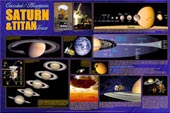


|

|
|
|
Cassini radar sees flow-like feature across Titan UNIVERSITY OF ARIZONA NEWS RELEASE Posted: November 8, 2004 A strikingly bright, lobate feature has turned up in one of Cassini's first radar images of Saturn's moon Titan. "It may be something that flowed," Cassini radar team member Ralph Lorenz of the University of Arizona said. "Or it could be something carved by erosion. It's too early to say. "But it looks very much like it's something that oozed across the surface. It may be some sort of 'cryovolcanic' flow, an analog to volcanism on Earth that is not molten rock but, at Titan's very cold temperatures, molten ice."
Cassini was flying about 1,550 miles (2,494 kilometers) above Titan's surface, with its radar centered at about 45 degrees north, 30 degrees west, when it mapped the 90-square-mile (230-square-kilometer) area shown in the new radar image. The Cassini radar team presented the image today at the 86th annual meeting of the American Astronomical Society Division of Planetary Sciences in Louisville, Ky. The radar instrument works by bouncing radio signals off Titan's surface and timing their return. The more signal reflected back to the spacecraft, the brighter the imaged area. Turning radio signals into radar images is time consuming because so many numerical calculations must be made. "There's no such thing as a 'raw' radar image," Lorenz said. But two days after the Oct. 26 flyby, Cassini scientists knew that Titan is no impact-crater-pocked dead world, but a much more interesting place. Titan's surface is young -- it's been shaped by dynamic geologic processing, Lorenz, Cassini interdisciplinary scientist Jonathan Lunine of the University of Arizona, and other Cassini scientists agree. Given this newest image, Lunine said, "Radar has provided the first evidence for possible young cryovolcanism on Titan's surface. Now our challenge is to find out what is flowing, how it works, and the implications for Titan's evolution." The Cassini-Huygens mission is a cooperative project of NASA, the European Space Agency and the Italian Space Agency. The Jet Propulsion Laboratory, a division of the California Institute of Technology in Pasadena, manages the Cassini-Huygens mission for NASA's Science Mission Directorate, Washington, D.C. The Cassini orbiter and its two onboard cameras were designed, developed and assembled at JPL. The radar instrument team is based at JPL, working with team members from the United States and several European countries. |
|
|
|
Cassini poster Just in time for the Cassini spacecraft's arrival at Saturn, this new poster celebrates the mission to explore the ringed planet and its moons. Just in time for the Cassini spacecraft's arrival at Saturn, this new poster celebrates the mission to explore the ringed planet and its moons.2005 Calendar  The 2005 edition of the Universe of the Hubble Space Telescope calendar is available from our U.S. store and will soon be available worldwide. This 12x12-inch calendar features spectacular images from the orbiting observatory. The 2005 edition of the Universe of the Hubble Space Telescope calendar is available from our U.S. store and will soon be available worldwide. This 12x12-inch calendar features spectacular images from the orbiting observatory.Moon panorama  Taken by Apollo 14 commander Alan Shepard, this panoramic poster shows lunar module pilot Edgar Mitchell as a brilliant Sun glare reflects off the lunar module Antares. Taken by Apollo 14 commander Alan Shepard, this panoramic poster shows lunar module pilot Edgar Mitchell as a brilliant Sun glare reflects off the lunar module Antares.Mars Rover mission patch  A mission patch featuring NASA's Mars Exploration Rover is now available from the Astronomy Now Store. A mission patch featuring NASA's Mars Exploration Rover is now available from the Astronomy Now Store. |
|||||||||||||||||||||